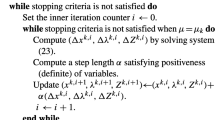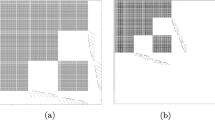Abstract
Several variants of an outer approximation method are proposed to solve truss topology optimization problems with discrete design variables to proven global optimality. The objective is to minimize the volume of the structure while satisfying constraints on the global stiffness of the structure under the applied loads. We extend the natural problem formulation by adding redundant force variables and force equilibrium constraints. This guarantees that the designs suggested by the relaxed master problems are capable of carrying the applied loads, a property which is generally not satisfied for classical outer approximation approaches applied to optimal design problems. A set of two- and three-dimensional benchmark problems are solved and the numerical results suggest that the proposed approaches are competitive with other special-purpose global optimization methods for the considered class of problems. Numerical comparisons indicate that the suggested outer approximation algorithms can outperform standard approaches suggested in the literature, especially on difficult problem instances.










Similar content being viewed by others
References
Achtziger, W., Kočvara, M.: Structural topology optimization with eigenvalues. SIAM J. Optim. 18(4), 1129–1164 (2007)
Achtziger, W., Stolpe, M.: Truss topology optimization with discrete design variables—guaranteed global optimality and benchmark examples. Struct. Multidiscip. Optim. 34(1), 1–20 (2007)
Achtziger, W., Stolpe, M.: Global optimization of truss topology with discrete bar areas—Part I: theory of relaxed problems. Comput. Optim. Appl. 40(2), 247–280 (2008)
Achtziger, W., Stolpe, M.: Global optimization of truss topology with discrete bar areas—Part II: implementation and numerical results. Comput. Optim. Appl. 44(2), 315–341 (2009)
Ben-Tal, A., Nemirovski, A.: Potential reduction polynomial time method for truss topology design. SIAM J. Optim. 4(3), 596–612 (1994)
Ben-Tal, A., Nemirovski, A.: Optimal design of engineering structures. OPTIMA Math. Program. Soc. Newsl. 47, 4–9 (1995)
Ben-Tal, A., Nemirovski, A.: Robust truss topology design via semidefinite programming. SIAM J. Optim. 7(4), 991–1016 (1997)
Ben-Tal, A., Nemirovski, A.: Handbook of Semidefinite Programming, chap. Structural Design. Kluwer, Dordrecht (2000)
Bendsøe, M., Sigmund, O.: Topology Optimization—Theory, Methods and Applications. Springer, Berlin (2003)
Bollapragada, S., Ghattas, O., Hooker, J.: Optimal design of truss structures by logical-based branch and cut. Oper. Res. 49(1), 42–51 (2001)
Cerveira, A., Agra, A., Bastos, F., Gromicho, J.: New branch and bound approaches for truss topology design with discrete areas. In: Proceedings of the American Conference on Applied Mathematics. Recent, Advances in Applied Mathematics, pp. 228–233 (2009)
Cook, R., Malkus, D., Plesha, M.: Concepts and Applications of Finite Element Analysis, 3rd edn. Wiley, New York (1989)
Dorn, W., Gomory, R., Greenberg, H.: Automatic design of optimal structures. J. de Mecanique 3, 25–52 (1964)
Duran, M., Grossmann, I.: An outer-approximation algorithm for a class of mixed-integer nonlinear programs. Math. Program. 36(3), 307–339 (1986)
Faustino, A., Judice, J., Ribeiro, I., Neves, A.S.: An integer programming model for truss topology optimization. Investigação Operacional 26, 111–127 (2006)
Fletcher, R., Leyffer, S.: Solving mixed integer nonlinear programs by outer approximation. Math. Program. 66, 327–349 (1994)
Gill, P., Murray, W., Saunders, M.: SNOPT: an SQP algorithm for large-scale constrained optimization. SIAM J. Optim. 12(4), 979–1006 (2002)
Glover, F.: Improved linear integer programming formulations of nonlinear integer problems. Manag. Sci. 22(4), 455–460 (1975)
Grossmann, I., Voudouris, V., Ghattas, O.: Recent Advances in Global Optimization, chap. Mixed-Integer Linear Programming Reformulations of Some Nonlinear Discrete Design Optimization Problems. Princeton University Press, Princeton (1992)
IBM: IBM ILOG CPLEX V12.1 User’s Manual for CPLEX (2012). http://www.ibm.com
Kesavan, P., Allgor, R., Gatzke, E., Barton, P.: Outer approximation algorithms for separable non-convex mixed-integer nonlinear programs. Math. Program. 100, 517–535 (2004)
Kočvara, M.: Truss topology design with integer variables made easy. Tech. rep., School of Mathematics, University of Birmingham, UK (2010). Preprint 2010/09. http://www.optimization-online.org
Kravanja, S., Kravanja, Z., Bedenik, B.: The MINLP optimization approach to structural synthesis, Part I: a general view on simultaneous topology and parameter optimization. Int. J. Numer. Methods Eng. 43(2), 263–292 (1998)
Kravanja, S., Kravanja, Z., Bedenik, B.: The MINLP optimization approach to structural synthesis, Part II: simultaneous topology, parameter and standard dimension optimization by the use of the linked two-phase MINLP strategy. Int. J. Numer. Methods Eng. 43(2), 293–328 (1998)
Lund, E., Stegmann, J.: On structural optimization of composite shell structures using a discrete constitutive parametrization. Wind Energy 8(1), 109–124 (2005)
Lobo, M., Vandenberghe, L., Boyd, S., Lebret, H.: Applications of second-order cone programming. Linear Algebra Its Appl. 284, 193–228 (1998)
McCormick, G.: Computability of global solutions factorable nonconvex programs. i. Convex underestimating problems. Math. Program. 10(2), 147–175 (1976)
Muñoz, E., Stolpe, M.: Generalized Benders’ decomposition for topology optimization problems. J. Glob. Optim. 51(1), 149–183 (2011)
Rasmussen, M., Stolpe, M.: Global optimization of discrete truss topology design problems using a parallel cut-and-branch method. Comput. Struct. 86(13–14), 1527–1538 (2008)
Stegmann, J., Lund, E.: Discrete material optimization of general composite shell structures. Int. J. Numer. Methods Eng. 62(14), 2009–2027 (2005)
Stolpe, M.: On the reformulation of topology optimization problems as linear or convex quadratic mixed 0–1 programs. Optim. Eng. 8, 163–192 (2007)
Stolpe, M.: On some fundamental properties of structural topology optimization problems. Struct. Multidisc. Optim. 41(5), 661–670 (2010)
Stolpe, M., Svanberg, K.: Modeling topology optimization problems as linear mixed 0–1 programs. Int. J. Numer. Methods Eng. 57(5), 723–739 (2003)
Svanberg, K.: On the convexity and concavity of compliances. Struct. Optim. 7(1–2), 42–46 (1994)
Svanberg, K., Werme, M.: On the validity of using small positive lower bounds on design variables in discrete topology optimization. Struct. Multidisc. Optim. 37, 325–334 (2009)
Vandenberghe, L., Boyd, S.: Semidefinite programming. SIAM Rev. 38, 45–95 (1996)
Acknowledgments
I extend sincere thanks to Professor Wolfgang Achtziger for valuable comments and suggestions on an early draft of this article. I would also like to thank the two anonymous reviewers for constructive comments and suggestions that improved the article.
Author information
Authors and Affiliations
Corresponding author
Additional information
The computing resources were funded by the Danish Center for Scientific Computing under the grant Optimal design of composite structures. The research is partially funded by The Danish Council for Independent Research—Technology and Production Sciences through the research project Optimal Design of Composite Structures under Manufacturing Constraints.
Rights and permissions
About this article
Cite this article
Stolpe, M. Truss topology optimization with discrete design variables by outer approximation. J Glob Optim 61, 139–163 (2015). https://doi.org/10.1007/s10898-014-0142-x
Received:
Accepted:
Published:
Issue Date:
DOI: https://doi.org/10.1007/s10898-014-0142-x




